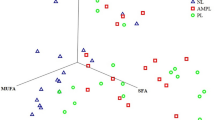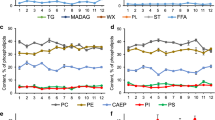Abstract
Neutral and polar lipids in the soft parts of a gastropod species, Ifremeria nautilei, collected from deep-sea hydrothermal vents, were examined to assess the trophic relationships in hydrothermal vents. The vent gastropod obtains many of its lipids from symbiotic chemosynthetic microorganisms. The major polyunsaturated fatty acids (PUFA) both in the triacylglycerols and phospholipids of the gastropod consist of a limited number of n-3 and n-6 PUFA: arachidonic acid (20:4n-6), icosapentaenoic acid (20:5n-3), and docosapentaenoic acid (22:5n-3), without docosahexaenoic acid (DHA, 22:6n-3). Noticeable levels of various n-6 PUFA, such as 18:2n-6,9, 20:2n-6,9, 20:3n-6,9,12, and 20:3n-6,9,15 with significant levels of 16:1n-6 and 18:1n-6 indicate the biosynthetic characteristic of the endosymbionts. The lack of DHA in all specimens suggests a limitation of its lipid biosynthesis ability with its symbionts. This finding with regard to the lipids is unusual for a marine animal in the grazing or detrital food chain because many marine animal lipids evidently contain high levels of DHA with low levels of n-6 fatty acids. Such contradictory findings lead to some new insights into the absence of a biosynthetic pathway for DHA in I. nautilei, and provide evidence that DHA in this species is dispensable. Similar to herbivorous gastropods, the lack of DHA with significant levels of n-6 PUFA in this species also indicates its selective assimilation of specific microorganisms, such as chemosynthetic bacteria in hydrothermal vents, because significant levels of DHA were found in carnivorous mollusk lipids.




Similar content being viewed by others
Abbreviations
- ARA:
-
Arachidonic acid
- DMA:
-
Dimethylacetals
- DMOX:
-
4,4-Dimethyloxazoline
- DHA:
-
Docosahexaenoic acid
- DPA:
-
Docosapentaenoic acid
- EPA (IPA):
-
Icosapentaenoic acid
- GC–MS:
-
Gas chromatography–mass spectroscopy
- MUFA:
-
Monounsaturated fatty acids
- NMID:
-
Non-methylene interrupted dienes
- NMR:
-
Nuclear magnetic resonance
- PtdCho:
-
Phosphatidylcholine
- PtdEtn:
-
Phosphatidylethanolamine
- PUFA:
-
Polyunsaturated fatty acids
- TAG:
-
Triacylglycerols
- TFA:
-
Total fatty acids
References
Ackman RG (1989) Fatty Acids. In: Ackman RG (ed) Marine biogenic lipids, fats and oils, vol I. CRC Press, Boca Raton, pp 103–137
Joseph JD (1989) Distribution and composition of lipids in marine invertebrates. In: Ackman RG (ed) Marine Biogenic Lipids, Fats and Oils, vol II. CRC Press, Boca Raton, pp 49–143
Morris RJ, Culkin F (1989) Fish. In: Ackman RG (ed) Marine biogenic lipids, fats, and oils, vol II. CRC Press, Boca Raton, pp 145–178
DeLong EF, Yayanos AA (1986) Biochemical function and ecological significance of novel bacterial lipids in deep-sea prokaryotes. Appl Environ Microbiol 51:730–737
Yano Y, Nakayama A, Saito H, Ishihara K (1994) Production of docosahexaenoic acid by marine bacteria isolated from deep-sea fish. Lipids 29:527–528
Saito H, Yamashiro R, Ishihara K, Xue C (1999) The lipids of three highly migratory fishes: Euthynnus affinis, Sarda orientalis, and Elagatis bipinnulata. Biosci Biotech Biochem 63:2028–2030
Saito H, Seike Y, Ioka H, Osako K, Tanaka M, Takashima A, Keriko JM, Kose S, Souza JCR (2005) High docosahexaenoic acid levels in both neutral and polar lipids of a highly migratory fish: Thunnus tonggol Bleeker. Lipids 40:941–953
Koizumi C, Jeong BY, Ohshima T (1990) Fatty chain composition of ether and ester glycerophospholipids in the Japanese oyster Crassostrea gigas (Thunberg). Lipids 25:363–370
Thompson PA, Harrison PJ (1992) Effects of monospecific algal diets of varying biochemical composition on the growth and survival of Pacific oyster (Crassostrea gigas) larvae. Mar Biol 113:645–654
Dunstan GA, Volkman JK, Barrett SM (1993) The effect of lyophilization on the solvent extraction of lipid classes, fatty acids and sterols from the oyster Crassostrea gigas. Lipids 28:937–944
Soudant P, Ryckeghem KV, Marty Y, Moal J, Samain JF, Sorgeloos P (1999) Comparison of the lipid class and fatty acid composition between a reproductive cycle in nature and a standard hatchery conditioning of the Pacific oyster Crassostrea gigas. Comp Biochem Physiol 123B:209–222
Saito H (2004) Lipid and FA composition of the pearl oyster Pinctada fucata martensii: influence of season and maturation. Lipids 39:997–1005
Napolitano GE, MacDonald BA, Thompson RJ, Ackman RG (1992) Lipid composition of eggs and adductor muscle in giant scallops (Placopecten magellanicus) from different habitats. Mar Biol 113:71–76
Pazos AJ, Sánchez JL, Román G, Pérez-Parallé ML, Abad M (2003) Lipid class fatty acid composition in the female gonad of Pecten maxima in relation to reproductive cycle and environmental variables. Comp Biochem Physiol 134B:367–380
Kraffe E, Soudant P, Marty Y, Kervarec N (2005) Docosahexaenoic acid- and eicosapentaenoic acid-enriched cardiolipin in the Manila clam Ruditapes philippinarum. Lipids 40:619–625
Kluytmans JH, Boot JH, Oudejand RCHM, Zandee DI (1985) Fatty acid synthesis in relation to gametogenesis in the mussel Mytilus edulis L. Comp Biochem Physiol 81B:959–963
Freites L, Fernandez-Reiriz MJ, Labarta U (2002) Fatty acid profiles of Mytilus galloprovincialis (Lmk) mussel of subtidal and rocky shore origin. Comp Biochem Physiol 132B:453–461
Saito H (2008) Unusual novel n-4 polyunsaturated fatty acids in cold-seep mussels (Bathymodiolus japonicus and Bathymodiolus platifrons), originating from symbiotic methanotrophic bacteria. J Chromatgr A 1200:242–254
Johns RB, Nichols PD, Perry GJ (1980) Fatty acid components of nine species of molluscs of the littoral zone from Australian waters. Comp Biochem Physiol 65B:207–214
Nelson MM, Leighton DL, Phleger CF, Nichols PD (2002) Comparison of growth and lipid composition in the green abalone, Haliotis fulgens, provided specific macroalgal diets. Comp Biochem Physiol 131B:695–712
Bouchet P, Waren A (1991) Ifremeria nautilei, nouveau gastéropode d’évents hydrothermaux, probablment associe à des bactéries symbiothique. C R Acad Sci Paris, Ser III 312:495–501
Galkin SV (1992) The benthic fauna of hydrothermal vents in the Manus Basin. Oceanology 32:768–774
Windoffer R, Giere O (1992) Symbiosis of the hydrothermal vent gastropod Ifremeria nautilei (Provannidae) with endobacteria—structural analyses and ecological considerations. Biol Bull 193:381–392
Erickson KL, Macko SA, Van Dover CL (2009) Evidence for a chemoautotrophically based food web at inactive hydrothermal vents (Manus Basin). Deep Sea Res II 456:1577–1585
Pranal V, Fiala-Médioni A, Guezennec J (1996) Fatty acid characteristics in two symbiotic gastropods from a deep hydrothermal vent of the West Pacific. Mar Ecol Prog Ser 142:175–184
Folch J, Lees M, Stanley GH (1957) A simple method for the isolation and purification of total lipids from animal tissues. J Biol Chem 226:497–509
Saito H (2007) Identification of novel n-4 series polyunsaturated fatty acids in a deep-sea clam, Calyptogena phaseoliformis. J Chromatogr A 1163:247–259
Ackman RG, Hooper SN (1973) Non-methylene-interrupted fatty acids in lipids of shallow-water marine invertebrates: a comparison of two molluscs (Littorina littorea and Lunatia triseriata) with the sand shrimp (Crangon septemspinosus). Comp Biochem Physiol 46B:153–165
Fulco AJ (1983) Fatty acid metabolism in bacteria. Prog Lipid Res 22:133–160
Thiele OW, Oulevey J, Hunneman DH (1984) Ornithine-containing lipids in Thiobacillus A2 and Achromobacter sp. Eur J Biochem 139:131–135
Knief C, Altendorf K, Lipski A (2003) Linking autotrophic activity in environmental samples with specific bacterial taxa by detection of 13C-labelled fatty acids. Environ Microbiol 5:1155–1167
Saito H, Osako K (2007) Confirmation of a new food chain utilizing geothermal energy: unusual fatty acids of a deep-sea bivalve, Calyptogena phaseoliformis. Limnol Oceanogr 52:1910–1918
Zhukova NV (1991) The pathway of the biosynthesis of non-methylene-interrupted dienoic fatty acids in molluscs. Comp Biochem Physiol 100B:801–804
Dunstan GA, Baillie HJ, Barrett SM, Volkman JK (1996) Effect of diet on the lipid composition of wild and cultured abalone. Aquaculture 40:115–127
DeLong EF, Yayanos AA (1985) Adaptation of the membrane lipids of a deep-sea bacterium to changes in hydrostatic pressure. Science 228:1101–1103
Yano Y, Nakayama A, Ishihara K, Saito H (1998) Adaptive changes in membrane lipids of barophilic bacteria in response to changes in growth pressure. Appl Environ Microbiol 64:479–485
Pond DW, Bell MV, Dixon DR, Fallick AE, Segonzac M, Sargent JR (1998) Stable carbon-isotope composition of fatty acids in hydrothermal vent mussels containing methanotrophic and thiotrophic bacterial endosymbionts. Appl Environ Microbiol 64:370–375
Budge SM, Parrish CC, Mckenzie CH (2001) Fatty acid composition of phytoplankton, settling particulate matter and sediments at a sheltered bivalve aquaculture site. Mar Chem 76:285–303
Owen JM, Adron JW, Middleton C, Cowey CB (1975) Elongation and desaturation of dietary fatty acids in turbot Scophthalmus maximus L., and rainbow trout Salmo gairdneri Rich. Lipids 10:528–531
Yamada K, Kobayashi K, Yone Y (1980) Conversion of linolenic acid to ω3 highly unsaturated fatty acids in marine fishes and rainbow trout. Bull Jap Soc Sci Fish 46:1231–1233
Ohshima T, Widjaja HD, Wada S, Koizumi C (1982) A comparison between cultured and wild Ayu lipids. Bull Jap Soc Fish 48:1795–1801
Acknowledgments
The authors thank Prof. Mutsumi Sugita, Shiga University, for kindly donating the authentic ceramide aminoethyl phosphonate which originated from the freshwater clam Corbicula sandai and for his valuable discussion of the bivalve lipids. The authors also thank Ms. Sumiko Terada, Ms. Mikiko Tanaka, and Mr. Akihito Takashima for their skilled technical assistance. This work was supported in part by a research project, “Development of New Technology for Treatment and Local Recycling of Biomass, D-2100” from the Ministry of Agriculture, Forestry, and Fisheries of Japan.
Author information
Authors and Affiliations
Corresponding author
About this article
Cite this article
Saito, H., Hashimoto, J. Characteristics of the Fatty Acid Composition of a Deep-Sea Vent Gastropod, Ifremeria nautilei . Lipids 45, 537–548 (2010). https://doi.org/10.1007/s11745-010-3436-x
Received:
Accepted:
Published:
Issue Date:
DOI: https://doi.org/10.1007/s11745-010-3436-x




